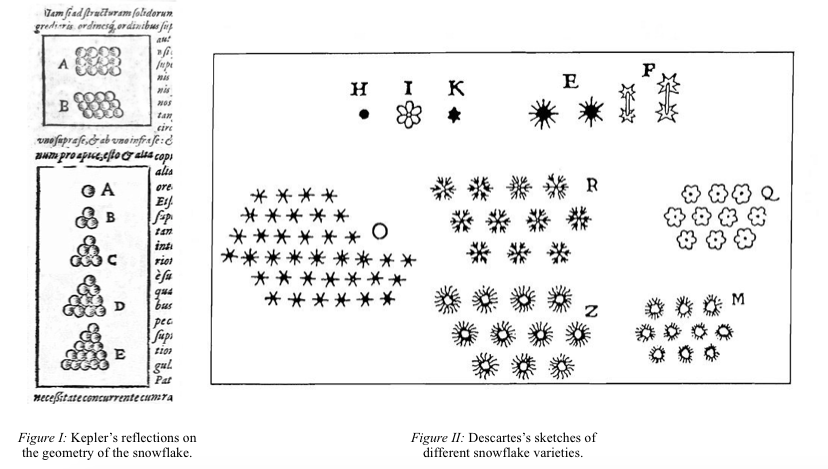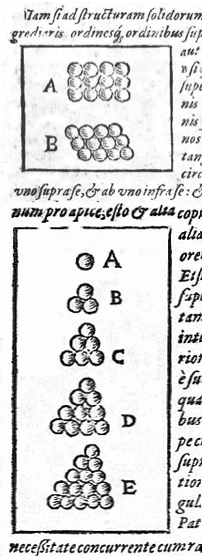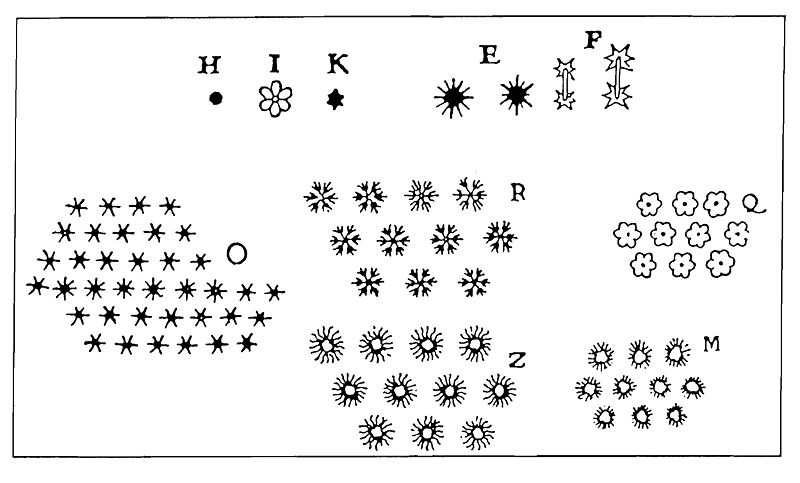AustLit
-
As a unique, natural phenomenon still partly unexplained today, the formation of the snow crystal has received attention from various philosophers and physicists over the centuries — the divided and varying theories on which are reflective of seventeenth-century metaphysical debates. Herein, the doctrine of mechanism began to emerge as a distinct divergence from the previously dominant philosophy of Aristotelian scholasticism, which sought to explain natural phenomena through universal hylomorphism. As the illustrations below demonstrate, mechanistic approaches to the physical conception of snowflakes and their hexagonal forms are notably present within the words of both Johannes Kepler (1571-1630) and Rene Descartes (1596-1650). As such, the images serve as visual representations of the rising influence of this nascent world view — illuminating both its departure from Aristotelian ‘natural philosophy’ and its subsequent emphasis on the physical processes behind causation. The improved effectiveness of their mechanistic theories in explaining snowflake formation ultimately attests to the legacy of this metaphysical doctrine, and subsequently justifies its divergence from previous scholasticism.
-
Figure I: By Johannes Kepler, 1611 - http://www.math.sunysb.edu/~tony/whatsnew/column/pennies-1200/cass1.html, Public Domain, https://commons.wikimedia.org/w/index.php?curid=1123076 and https://commons.wikimedia.org/wiki/File:Kepler_conjecture_1.jpg; Figure II: By Rene Descartes, 1637 - http://mathsoc.jp/publication/tushin/0203/mimura2-3.pdf, Public Domain, https://commons.wikimedia.org/wiki/File:Sketch_of_snow_crystal_by_Ren%C3%A9_Descartes.jpg700396assertion
~
Antedating by more than a millennium the first Aristotelian-inspired studies on snowflakes in the West, Chinese scholars wrote of snow crystals as early as 135 BCE (Ball 2011: 2). Herein, their hexagonal shape was explained through a numerological and pattern-based view of nature, in which specific numbers were seen to correspond to certain elements. Accordingly, water’s symbolic association with the number six within Chinese thought provided a satisfactory explanation as to the snowflake’s hexagonal form — as scholar T’ang Chin wrote in the Ming period, “since six is the true number of Water, when water congeals into flowers they must be six-pointed.” (cited in Needham 1970: 102).
Despite such an early discovery of this phenomena, however, records from ensuing centuries indicate apparently minimal development within Chinese enquiries into the snowflake’s causation process (Ball 2011: 2; Needham 1970: 102). While noting the additional association of snowflakes with the selenite mineral, which prefigured the later development of cloud-seeding processes, Joseph Needham thus observes that “our general impression is that the Chinese, having found hexagonal symmetry, were content to accept it as a fact of Nature and to explain it [merely] in accordance with the numerology of the symbolic correlations.” (1970: 102-3). Acknowledging the limitations of these numerological accounts of snowflakes — in both their lack of explanatory sophistication and their tendency to stifle further enquiry — can only illuminate certain merits of the Scholastic approach which was to ensue.
While Aristotle’s hylomorphism would in this way prove somewhat lucrative to theories on snowflake causation, its reliance on teleology ultimately hindered its overall capacity for metaphysical explanation. Aristotelian conceptions of causation relied on a form/matter distinction, or hylomorphism, under which all substances were comprised of both matter (their material potentiality) and a form or essence which realised that potentiality, organising it into a recognisable substance and thus constituting the properties without which the substance would cease to exist as itself. Additionally, Aristotle theorised four types of causes responsible for a substance’s creation: material (its physical properties); formal (its structure or design); efficient (the influence of external forces); and final (its ultimate purpose).
As Ronald de Sousa observes, the application of a worldview informed by such theories on snow crystals has obvious merits (Sousa 2007). Not only did this scholastic approach represent a distinct departure from previous numerological explanations, but it justifiably emphasised a substance’s physical properties and structural design. By theorising that both the matter and essence of which a substance was constituted contributed to the complete explanation of any given phenomenon, Aristotelian theory drew attention not only to the snowflake’s material structure, which as modern technology reveals is central to its hexagonal form, but to its specific shape — which highlighted the fact that the moment it melted, it would cease to be a ‘flake’ despite not changing its matter (Sousa 2007).
Regardless of these theoretical advances, however, the Aristotelian approach ultimately falls short of a comprehensive account of the snowflake’s physical causation process, and is additionally hindered by its teleological undertones. These are contained within Aristotle’s ‘final cause,’ which occupies a central place in his physics as the foremost causal determinant of natural change (van Ruler 1995: 86; Leunissen 2010: 209). In according this status to that which describes the ultimate end or purpose of natural processes, Aristotle’s worldview was inherently reliant on natural teleology. As Jan Fennema and Iain Paul identify, employing this view within physical accounts of causation is problematic in that it presupposes that nature is riddled with purpose “which is itself uncaused and unchangeable and as such outside the material world of the elements.” (Fennema & Iain 2012: 144).
While it is perhaps tempting to apply this concept to the snowflake’s uniquely self-organising structure, it has since been widely challenged within modern philosophy. As Sousa writes, “order is not synonymous with teleology. There is a huge diversity of highly organised forms… [among snowflakes] but that doesn’t mean that snowflakes aim at any goal or that their forms should be explained teleologically.” (2007: 10).Critiques such as these would increase within following centuries, partly accounting for the ultimate demise of natural philosophy and the subsequent supremacy of an alternative worldview.
-
Emerging in response to Aristotelian scholasticism, mechanistic explanations of snowflakes as advanced by both Kepler and Descartes predominantly sought to understand the phenomenon through the physical process of particle agglomeration — the legacy of which remains in evidence today. In 1611, Kepler penned an essay, Strena seu De nive sexangula, which explored the origins of the snow crystal’s hexagonal form, and which has been hailed as “the real beginning of knowledge of snowflakes in Europe” (Needham 1970: 99). Although Kepler’s worldview failed to constitute an entirely distinct departure from natural philosophy, in that he continued to employ some Aristotelian notions of causation, his points of divergence were nonetheless indicative of the wider shift toward a more mechanical and mathematical view of the cosmos (Chapp 2011: 78).
Larry Chapp offers an example of this, arguing that: "Kepler reduced the concept of [Aristotle’s] formal cause almost entirely to the role played by mathematical relations as the determinative measure for why a thing is the way it is. Thus [collapsing] the Aristotelian notion of quality and teleology… into the act of mathematical quantification." (2011: 78). Accordingly, Kepler’s conception of causative forces rejected teleological explanations; as he argued, although some might claim that the creation of a definite natural body indicates “the pre-existence of a formative principle in some matter… no purpose can be observed in the shaping of a snowflake; the six corner shape does not bring it about that the snowflake lasts, or that a definite natural body assumes a precise and durable shape.” (2010: 89).
~
Although ultimately inconclusive in its findings, his treatise sought to conceptualise the snowflake’s structure in terms of the close-packing of condensed water globules (Figure I), and subsequently “established the idea that the geometric shapes of crystals are related to the ordered arrangements of their component units.” (Ball 2011: 5). The influence of this somewhat elementary notion on the emerging science of crystallography and farther afield was significant, described by Wolfgang Lefèvre et al as “a view that was to have a considerable effect on the development of mechanistic models of matter in general, and of crystalline forms in particular.” (2003: 129). Similarly, Descartes, who was aware of these observations (Authier 2013), contemplated the snowflake's causal process through a mechanist lens.
-
Descartes's rejection of the teleology contained within scholastic accounts of causation has long been widely acknowledged (van Ruler 1995; Ott 2009; Simmons 2011). As J.A. van Ruler has observed, although Aristotle’s original teleological explanations were not actually reliant on notions of divine providence, his finalistic concept of causality was subsequently incorporated into the theological body of Christian dogma with the advent of Aquinas and later scholastics (1995: 91).
~
Accordingly, Descartes’s opposition to teleological accounts of causation related predominantly to their theological implications. Despite concurring with the common scholastic view of God as the primary cause of all natural phenomena, he criticised teleology as falsely presuming a true understanding of God’s nature and intentions, which was in his view beyond finite human capabilities. As he wrote in his Meditations: “I consider the sort of cause which is customarily derived from an end to have no use in physics: for it is not without rashness that I think myself capable of investigating the ends of God.” (cited in Simmons 2001: 4).
Descartes thus repudiated the use of final causation within Aristotelian natural philosophy — however, his critique was accompanied by an underlying epistemological optimism that the world’s physical processes could instead be understood through mechanical explanations (van Ruler 1995: 141). Herein, he asserted that a true understanding of God’s impact on natural causation could be achieved insofar as we can elicit knowledge from the one guaranteed truth concerning God's nature; that is, His immutability (Ott 2009: 53). As such, he argued, natural causation could therefore only be explained with reference to the mechanical processes regulated by the ‘laws’ of Nature. This is because God’s unchanging nature by extension ensures the immutability of the processes by which He governs natural causation, and these processes can thus be said to constitute a priori ‘laws’ rather than mere regularities.
Descartes’s work on snowflake formation processes offers a felicitous example of his resulting mechanical approach to natural causation. In his 1637 Discourse on the Method, he provided remarkably accurate sketches of various snow crystal shapes (Figure II), including many rarer varieties which hinted at the effects of temperature changes on their physical composition (Sousa 2007; Authier 2013). Dispensing with the formative forces of natural philosophy, Descartes theorised that all visible form was the result of the congregation of particles which themselves had a particular determination of direction (Robertson et al., 2008: 31).
Accordingly, he explained the snow crystal’s hexagonal shape through the physical process of particle agglomeration, wherein six small grains collected around a central one. As he elucidates, demonstrating his commitment to a belief in the ‘Laws of Nature’: "I had some difficulty imagining what could have so accurately assembled six little teeth around each grain, in the middle of free air and by a strong wind, until I considered that this very wind could have flown away some of these little grains outside a cloud and held them up, since they were so small. There, they must have organised themselves in such a way that each of them was surrounded by six others, in the usual way of nature." (cited in Authier 2013: 292).
Kepler’s and Descartes’s explanations are in hindsight fundamentally limited by a lack of technological advances — indeed, attempts to explain snowflakes continue today. Despite this, their significant contribution to both crystallography and wider mechanistic models is clear, and as such, ultimately attests to the effectiveness of mechanism as a metaphysical response to Aristotelian natural philosophy.
You might be interested in...







